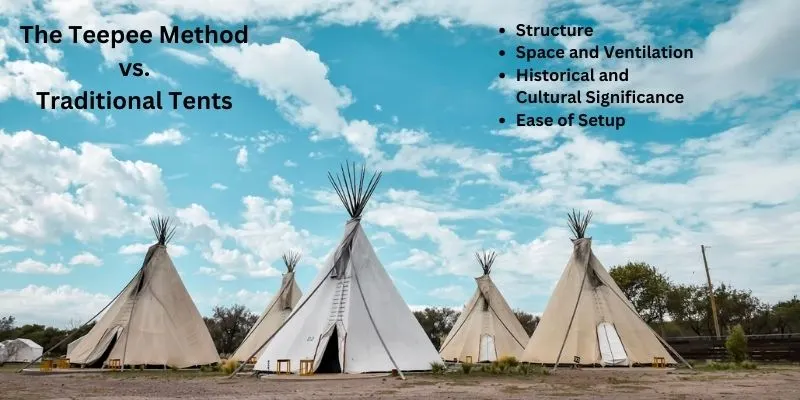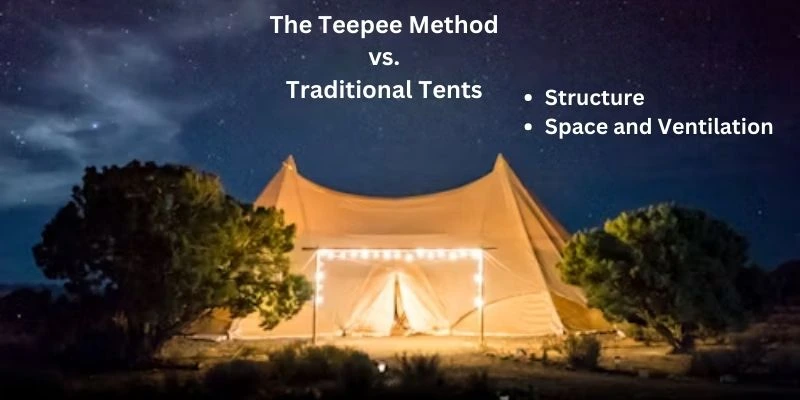The Teepee Method vs. Traditional Tents: Pros and Cons – 5 Key Points
Updated: 27 Feb 2024
260
Choosing the right camping shelter can be tough with so many options. But don’t worry! We’re here to help. In this blog post, we’re going to talk about two main types of shelters: teepees and traditional tents and we also discuss the pros and cons of The Teepee Method vs. Traditional Tents. We’ll take a close look at what makes each one great, as well as some things you might want to consider before making your decision. Whether you’re a camping pro or just starting, our goal is to give you all the info you need to pick the perfect shelter for your next best outdoor adventure.
So, grab a snack and get ready to learn all about camping shelters! When stepping into the wilderness, the choice of shelter is a pivotal decision affecting comfort, convenience, and overall outdoor experience.
This guide compares two distinct sheltering options: the Teepe Method Guide Method and traditional tents detailing their pros, cons, key differences, and ideal use cases to help campers and outdoor adventurers decide which is best for their next adventure.
The Teepee Method
The Teepee Method is a simple and smart way to put up a tent when camping in a state park. It’s called this because it’s like the shape of a teepee, the traditional homes of some Native American tribes. To use this method, you arrange the tent poles in a triangle shape and then put the tent fabric over them. This helps the tent stay steady, gives you plenty of room inside, and lets rainwater run off easily.
Many campers like this method because it’s fast and dependable. Whether you’re new to camping or a seasoned pro, learning the Teepee Method can make your camping trip better by giving you a safe and attractive place to sleep in the beauty of nature.

The Traditional Tents
For many years, traditional tents have been an important part of camping. They give people a place to stay safe and feel at home while they’re out in nature. These tents are well-known and often made from strong fire-resistant materials like fabric and poles that hold them up. They remind us of nature and going on adventures. There are different kinds of traditional tents, like the classic.
A-frame or the attractive dome ones. Each type has its special features that make it useful and bring back memories. People who camp in these tents can relax and enjoy nature while feeling safe. It doesn’t matter if the tents are set up under the stars or in the middle of a forest—they’re always a symbol of exploring and being together outside.
Key Differences
1. Structure
The Teepee Technology Method utilizes a simple yet elegant design with a single central support pole around which fabric is draped to create a conical shape. In contrast, traditional tents typically feature multiple poles that form rectangular or dome shapes with more complex structural designs.
2. Space and Ventilation
A teepee’s conical shape allows for efficient utilization of space and natural ventilation. Traditional tents, while often sectioned into compartments, may require additional rain flies and can suffer from poorer airflow.
3. Historical and Cultural Significance
A teepee is more than just a shelter—it represents historical and cultural heritage. Traditional tents lack this cultural significance but are a familiar and ubiquitous sight at campgrounds worldwide.
4. Ease of Setup
Setting up traditional tents can be straightforward with instant or pop-up options available. Teepees, however, often demand more time and effort to erect properly.
Use Cases and Scenarios
Teepee Method
Ideal for:
- Backpackers seeking a lightweight, portable shelter
- Minimalists who appreciate the spacious interior and simplicity
- Adventurers interested in cultural camping experiences

Traditional Tents
Perfect for:
- Family camping with a need for separate sleeping quarters
- Campers requiring resilient shelters for diverse weather conditions
- Those preferring an easy and quick setup to maximize relaxation time
Pros and Cons of The Teepee Method vs. Traditional Tents
The Teepee Method
| Pros |
|---|
|
| Cons |
|---|
|
The Traditional Tents
| Pros |
|---|
|
| Cons |
|---|
|
Expert Quotes
“The Teepee Method offers a blend of tradition and practicality, making it a favorite among those who seek a cultural camping experience.”
John Smith, Outdoor Enthusiast asserts,
Let’s see what next
“Traditional tents are a staple of family camping, providing the comfort and protection needed for a variety of weather conditions.”
Jane Doe, Camping Expert
Let’s see what next
“Ventilation and space are key factors in choosing a shelter. Teepees excel in these areas, especially for solo campers or minimalists.”
Chris Green, Backpacking Guide adds
FAQs
Which is better for backpacking, a teepee or traditional tent?
It ultimately depends on personal preference and the type of backpacking trip planned. Teepees are generally lighter and more portable but may take longer to set up. Traditional tents offer a variety of sizes and designs but may be heavier to carry. Consider your needs and choose accordingly.
Are there any safety concerns with using a teepee?
As with any shelter, proper setup and precautions should be taken to ensure safety. For example, setting up a fire inside a teepee requires extra caution to prevent accidents and potential damage to the shelter.
Can a teepee accommodate multiple people?
Yes, depending on the size of the teepee and the number of occupants, a teepee can comfortably accommodate multiple people. However, traditional tents may offer more options for separate sleeping quarters.
Can a teepee withstand strong winds?
Yes, depending on the quality of materials and proper setup techniques, a sturdy teepee can withstand high winds. However, traditional tents may have an edge in this aspect due to their more complex structural design.
Are teepees only suitable for warm-weather camping?
No, teepees can be used in various weather conditions with proper preparation and gear. However, traditional tents may offer better insulation and protection from harsh elements.
Conclusion
Both teepees and tents have unique advantages for those drawn to romantic nostalgia or modern practicality. Consider your specific camping scenario—be it a solo minimalist adventure or a family retreat in the great outdoors—and choose wisely to ensure a harmonious balance between tradition, comfort, and utility on your outdoor escapades.
Remember, the best shelter is the one that suits your needs and enhances your connection with nature. Enjoy camping!
Please Write Your Comments